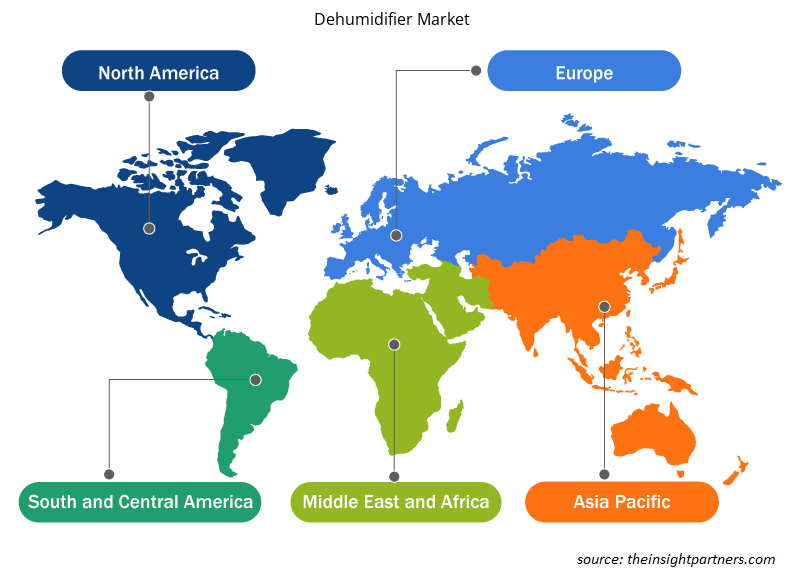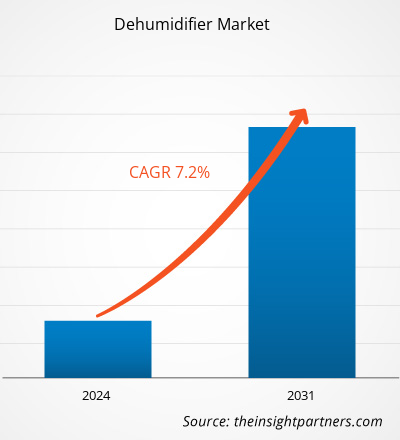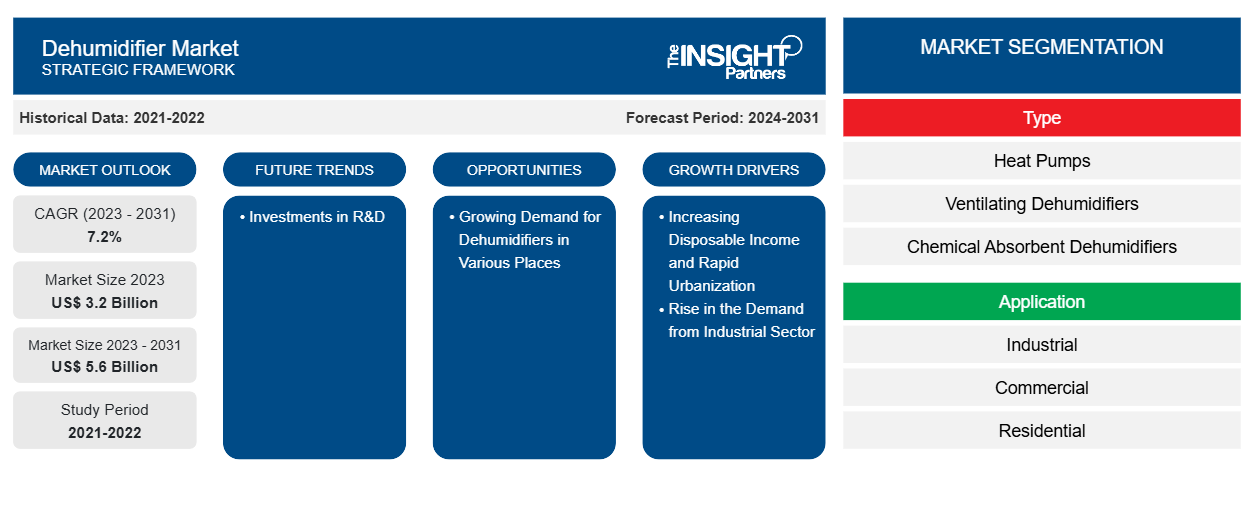Der Markt für Luftentfeuchter soll von 3,2 Milliarden US-Dollar im Jahr 2023 auf 5,6 Milliarden US-Dollar im Jahr 2031 anwachsen. Der Markt wird zwischen 2023 und 2031 voraussichtlich eine durchschnittliche jährliche Wachstumsrate von 7,2 % verzeichnen. Steigendes verfügbares Einkommen und rasche Urbanisierung werden voraussichtlich weiterhin die wichtigsten Trends auf dem Markt bleiben.
Luftentfeuchter Marktanalyse
Die Verbesserung der Weltwirtschaft, begleitet von der Stadtentwicklung, hat zu einem Anstieg der Bautätigkeit in verschiedenen Sektoren geführt. Dieser Bauboom, der Einkaufszentren, Krankenhäuser, Bürogebäude, Hotels und Industrieanlagen umfasst, hat den Bedarf an Luftentfeuchtern erhöht. Der technologische Fortschritt und die Entwicklung von Vorschriften zur Energienutzung auf Regierungs- und Organisationsebene haben ebenfalls zur Expansion des Marktes beigetragen. Es gibt eine zunehmende Tendenz zu fortschrittlichen Luftentfeuchtern, die die Luftfeuchtigkeit selbstständig messen und regulieren können, sowie zur Integration von Cloud-basierter Technologie, die die Konnektivität mit intelligenten Geräten ermöglicht, was das Marktwachstum erheblich beschleunigt hat.
Marktübersicht für Luftentfeuchter
Von der Regierung auferlegte Vorschriften, wie die vom US- Energieministerium festgelegten Prüfkriterien für Energieeffizienz , wirken sich erheblich auf das Marktverhalten aus. Darüber hinaus wird der Markt durch einen verbesserten Lebensstandard und ein wachsendes Verbraucherbewusstsein in Bezug auf gesundheitsbezogene Faktoren positiv beeinflusst. Der steigende Bedarf an tragbaren Luftentfeuchtern in Privathaushalten und Unternehmen, gepaart mit der Integration benutzerfreundlicher digitaler Steuerungen in moderne Luftentfeuchtereinheiten, treibt das Marktwachstum voran, insbesondere im Wohnbereich. Darüber hinaus fördern auf Energieeffizienz ausgerichtete staatliche Vorschriften und Standards wie AHAM 7008-2018/ CSA SPE-7008-18/UL 7008-18 den Einsatz von Luftentfeuchtern im Wohn- und Industriebereich weiter. Diese kombinierten Faktoren tragen maßgeblich zum allgemeinen Marktwachstum bei.
Passen Sie diesen Bericht Ihren Anforderungen an
Sie erhalten kostenlos individuelle Anpassungen an jedem Bericht, einschließlich Teilen dieses Berichts oder einer Analyse auf Länderebene, eines Excel-Datenpakets sowie tolle Angebote und Rabatte für Start-ups und Universitäten.
-
Holen Sie sich die wichtigsten Markttrends aus diesem Bericht.Dieses KOSTENLOSE Beispiel umfasst eine Datenanalyse von Markttrends bis hin zu Schätzungen und Prognosen.
Markttreiber und Chancen für Luftentfeuchter
Steigendes verfügbares Einkommen und schnelle Urbanisierung begünstigen den Markt
Der globale Markt für Luftentfeuchter wächst aufgrund mehrerer Schlüsselfaktoren. Der zunehmende Einsatz von Luftentfeuchtern in gewerblichen und privaten Räumen sowie die schnelle Urbanisierung und das steigende verfügbare Einkommen treiben dieses Wachstum voran. In verschiedenen Entwicklungsländern im asiatisch-pazifischen Raum steigt die Nachfrage nach Luftentfeuchtern aufgrund der wachsenden Investitionen in Bautätigkeiten für Wohn- und Gewerberäume. Diese Nachfrage ist besonders in Lagerräumen zu beobachten, in denen Lithiumbatterien und andere elektronische Geräte gelagert werden. Darüber hinaus tragen die schwankenden Wetterbedingungen, die durch Faktoren wie die globale Erwärmung verursacht werden, zum Wachstum des Luftentfeuchtermarktes bei. In Europa wird die Nachfrage nach Luftentfeuchtern in den kommenden Jahren voraussichtlich steigen, insbesondere in Einrichtungen wie Restaurants, Hotels, Resorts, Cafeterias, Lebensmittel- und Getränkeverarbeitungszentren und Kühlräumen.
Wachsende Nachfrage nach Luftentfeuchtern an verschiedenen Orten
Fitnessstudios benötigen kommerzielle Luftentfeuchter nicht nur in Schwimmbädern und Spa-Bereichen, sondern auch in feuchtigkeitsreichen Trainingsräumen. Diese Luftentfeuchter sind unerlässlich, um die Feuchtigkeit zu kontrollieren, Problemen wie Schimmel und Mehltau vorzubeugen, das Rosten von Trainingsgeräten zu verhindern und die allgemeine Integrität des Gebäudes zu erhalten . In kompakten, feuchten Räumen wie Therapiebecken, Whirlpools oder Spas wird ein kommerzieller Luftentfeuchter eingesetzt, um überschüssige Feuchtigkeit zu entfernen. Darüber hinaus sind aufgrund des im Vergleich zur produzierten Feuchtigkeit relativ begrenzten Raumvolumens spezielle kommerzielle Luftentfeuchter mit geringem CFM- Volumen erforderlich, um die Anzahl der Raumluftwechsel, die durch den Luftentfeuchter strömen, auf ein geeignetes Maß zu begrenzen. All diese Vorteile von Luftentfeuchtern dürften die Akzeptanz dieses Produkts steigern.
Luftentfeuchter Marktbericht Segmentierungsanalyse
Wichtige Segmente, die zur Ableitung der Marktanalyse für Luftentfeuchter beigetragen haben, sind Typ und Anwendung.
- Je nach Typ ist der Markt in Wärmepumpen, Lüftungsentfeuchter und chemische Absorptionsentfeuchter unterteilt. Das Segment Wärmepumpen hatte im Jahr 2023 einen bedeutenden Marktanteil.
- In Bezug auf die Anwendung ist der Markt in Industrie, Gewerbe und Wohnen unterteilt. Das Industriesegment hielt im Jahr 2023 einen erheblichen Marktanteil.
Luftentfeuchter Marktanteilsanalyse nach Geografie
Der geografische Umfang des Marktberichts für Luftentfeuchter ist hauptsächlich in fünf Regionen unterteilt: Nordamerika, Asien-Pazifik, Europa, Naher Osten und Afrika sowie Süd- und Mittelamerika.
Nordamerika wird voraussichtlich eine bedeutende Marktposition einnehmen. Unternehmen wie die Dehumidifier Corporation of America (DCA) bieten in dieser Region eine breite Palette von Luftbefeuchtern an. Kommerzielle Schwimmbadüberdachungen und Spa-Einrichtungen in Hotels, Fitnessstudios, YMCAs, YWCAs, High Schools, Universitäten, Seniorenresidenzen, Fitnesscentern und anderen ähnlichen Einrichtungen können durch den Einsatz von DCA-Luftentfeuchtern verbesserte Bedingungen erfahren, insbesondere bei der Bekämpfung hoher Feuchtigkeitsansammlungen.
Regionale Einblicke in den Luftentfeuchtermarkt
Die regionalen Trends und Faktoren, die den Luftentfeuchtermarkt während des Prognosezeitraums beeinflussen, wurden von den Analysten von Insight Partners ausführlich erläutert. In diesem Abschnitt werden auch die Marktsegmente und die Geografie des Luftentfeuchtermarkts in Nordamerika, Europa, im asiatisch-pazifischen Raum, im Nahen Osten und Afrika sowie in Süd- und Mittelamerika erörtert.

- Holen Sie sich die regionalspezifischen Daten für den Luftentfeuchtermarkt
Umfang des Marktberichts über Luftentfeuchter
| Berichtsattribut | Details |
|---|---|
| Marktgröße im Jahr 2023 | 3,2 Milliarden US-Dollar |
| Marktgröße bis 2031 | 5,6 Milliarden US-Dollar |
| Globale CAGR (2023 - 2031) | 7,2 % |
| Historische Daten | 2021-2022 |
| Prognosezeitraum | 2024–2031 |
| Abgedeckte Segmente |
Nach Typ
|
| Abgedeckte Regionen und Länder |
Nordamerika
|
| Marktführer und wichtige Unternehmensprofile |
|
Marktteilnehmerdichte: Der Einfluss auf die Geschäftsdynamik
Der Markt für Luftentfeuchter wächst rasant, angetrieben durch die steigende Nachfrage der Endverbraucher aufgrund von Faktoren wie sich entwickelnden Verbraucherpräferenzen, technologischen Fortschritten und einem größeren Bewusstsein für die Vorteile des Produkts. Mit steigender Nachfrage erweitern Unternehmen ihr Angebot, entwickeln Innovationen, um die Bedürfnisse der Verbraucher zu erfüllen, und nutzen neue Trends, was das Marktwachstum weiter ankurbelt.
Die Marktteilnehmerdichte bezieht sich auf die Verteilung der Firmen oder Unternehmen, die in einem bestimmten Markt oder einer bestimmten Branche tätig sind. Sie gibt an, wie viele Wettbewerber (Marktteilnehmer) in einem bestimmten Marktraum im Verhältnis zu seiner Größe oder seinem gesamten Marktwert präsent sind.
Die wichtigsten auf dem Luftentfeuchtermarkt tätigen Unternehmen sind:
- Haier Group Corporation
- Electrolux AB
- LG Electronics
- Whirlpool Corporation
- De'Longhi Appliances Srl
- General Filters, Inc.
Haftungsausschluss : Die oben aufgeführten Unternehmen sind nicht in einer bestimmten Reihenfolge aufgeführt.

- Überblick über die wichtigsten Akteure auf dem Luftentfeuchtermarkt
Neuigkeiten und aktuelle Entwicklungen auf dem Luftentfeuchtermarkt
Der Luftentfeuchtermarkt wird durch die Erhebung qualitativer und quantitativer Daten nach Primär- und Sekundärforschung bewertet, die wichtige Unternehmensveröffentlichungen, Verbandsdaten und Datenbanken umfasst. Nachfolgend sind einige der Entwicklungen auf dem Luftentfeuchtermarkt aufgeführt:
- Quest Climate, ein Pionier in der Feuchtigkeitsregulierungsbranche, freut sich, eine strategische Partnerschaft mit BFG Supply, einem renommierten Vertriebshändler für Garten-, Baumschul- und Gartenbauprodukte, ab 2024 bekannt zu geben. Diese Zusammenarbeit stellt einen spannenden Meilenstein für beide Unternehmen dar und zielt darauf ab, die Standards bei Umweltkontrolllösungen für die Garten- und Anbaubranche neu zu definieren. Quest ist seit jeher Marktführer mit innovativer, leistungsstarker Entfeuchtungstechnologie, die den vielfältigen Anforderungen von Anbauumgebungen und industriellen Anwendungen gerecht wird. Mit seinem Engagement für Zuverlässigkeit, Energieeffizienz und Nachhaltigkeit hat sich Quest einen Ruf für Exzellenz erworben und ist zur ersten Wahl für Züchter weltweit geworden.
(Quelle: Quest, Unternehmenswebsite, Dezember 2023)
- AprilAire, der landesweit führende Anbieter professioneller Healthy Air-Lösungen für das Zuhause, bietet mit seiner Luftentfeuchter-Reihe der E-Serie inspirierte Innovationen und nachgewiesene Energieeinsparungen. Die Modelle E080, E100 und E130 bieten Verbrauchern im Vergleich zu herkömmlichen Produkten eine jährliche Energieeinsparung von 23 % und verfügen über die Bewertung ENERGY STAR® Most Efficient 2022. Diese Luftentfeuchter von AprilAire sind die ersten Luftentfeuchter für das ganze Haus, die diese Zertifizierung von ENERGY STAR erhalten haben, und sie haben die Bewertung zwei Jahre in Folge erhalten.
(Quelle: AprilAire, Unternehmenswebsite, April 2022)
Marktbericht zu Luftentfeuchtern – Umfang und Ergebnisse
Der Bericht „Marktgröße und Prognose für Luftentfeuchter (2021–2031)“ bietet eine detaillierte Analyse des Marktes, die die folgenden Bereiche abdeckt:
- Luftentfeuchter-Marktgröße und -prognose auf globaler, regionaler und Länderebene für alle wichtigen Marktsegmente, die im Rahmen des Berichts abgedeckt sind
- Markttrends für Luftentfeuchter sowie Marktdynamik wie Treiber, Einschränkungen und wichtige Chancen
- Detaillierte PEST/Porters Five Forces- und SWOT-Analyse
- Marktanalyse für Luftentfeuchter mit Blick auf wichtige Markttrends, globale und regionale Rahmenbedingungen, wichtige Akteure, Vorschriften und aktuelle Marktentwicklungen
- Branchenlandschaft und Wettbewerbsanalyse, einschließlich Marktkonzentration, Heatmap-Analyse, prominenten Akteuren und aktuellen Entwicklungen auf dem Luftentfeuchtermarkt
- Detaillierte Firmenprofile
- Historische Analyse (2 Jahre), Basisjahr, Prognose (7 Jahre) mit CAGR
- PEST- und SWOT-Analyse
- Marktgröße Wert/Volumen – Global, Regional, Land
- Branchen- und Wettbewerbslandschaft
- Excel-Datensatz
Aktuelle Berichte
Erfahrungsberichte
Grund zum Kauf
- Fundierte Entscheidungsfindung
- Marktdynamik verstehen
- Wettbewerbsanalyse
- Kundeneinblicke
- Marktprognosen
- Risikominimierung
- Strategische Planung
- Investitionsbegründung
- Identifizierung neuer Märkte
- Verbesserung von Marketingstrategien
- Steigerung der Betriebseffizienz
- Anpassung an regulatorische Trends























 Kostenlose Probe anfordern für - Markt für Luftentfeuchter
Kostenlose Probe anfordern für - Markt für Luftentfeuchter